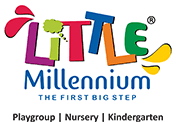
Why Should Your Preschooler Dance More Often
Walking is the job of our feet Dancing is their hobby!
If you walk into your child’s preschool and see a lot of music and dance happening, be rest assured that you have chosen the right preschool for your child.
Children are born to move, not to sit still.
And by movement, I mean natural, rhythmic, innate movement.Children are born with a natural rhythm and flexibility.
When we try to curb that innate flexibility and encourage only practiced or choreographed moves, we are killing the natural instinct of the child. So let your children move! In early childhood, movement means to jump, sing and dance. The more they dance, the better the control they have over their body and their emotions.
At Little Millennium, the curriculum is built around nurturing this innate instinct of every child.
● We sing our yoga poems and dance around our yoga stories.
● We turn our stories into poems and dance with the characters.
● We learn our cognitive concepts by dancing with the parachute.
● We learn spatial skills by dancing with the pool noodles.
● We learn our alphabets and dance around with them.
● We learn our alphabets and dance around with them.
● And a host of other such fun stuff!
How can the parent help in nurturing the movement skills of their child:
● To raise a child, be a child (at times).
● Sing and dance with your children as often as possible.
● Do not lay over emphasis on choreographed movements. Let your child move any which way to all rhythms.
● Do not remain a spectator when your child is attempting to dance. Join them as often as possible.
● Try to sing a story at bed time, every once in a while.
● Try to sing your conversation with your child, few times a week. “What ….did……you ….. laugh……at…..in….. school….today ?” “What ….did….you…..colour…..today ……?”
● Coin a secret dance with your child and use it to calm down your child in stressful situations.
● Coin a goodbye dance or a welcome home dance, with your child. Do that when you reach home, as often as possible.
● Minimize watching online or screen dance performances. Turn the online to real. It will help your child gain more confidence and motor control.
● It is easy to switch to screens to destress after a day’s hard work. Try to reverse the trend. Try some music and rhythm with your child, instead.
● Remember, one of the best ways to get any child engaged is to make sure they can see the fun in an activity. Children like to have fun and use natural explorative senses to find out more about the world. The best way to combine that, then, is with dancing!
5 signs to know if your child’s innate rhythm is being nurtured:
● Your child loves to move along with singing rhymes. They don’t just lip sing the rhymes, they move along while singing. This means that they are actually building a concept – meaning relationship. They are building a muscle memory.
● Your child tends to listen or tell a story, gesticulating with their hands and parts of body. “There was a bigggggg mountain and a really fast flyingggggg crow”. The more they gesticulate, the more is the whole body learning. It means that several parts of their brain are being fired together.
● Your children begin to move at the first sound of music, wherever they are. Be it at a party, at a cinema hall, at the shopping mall or even while listening to grandma’s Caravan radio. It means their natural rhythm is not being stifled and they are being encouraged to move at their pace and timing.
● Your child has a smile and attempts to sing a rhythm while being engrossed in self play / onlooker play / unoccupied play. This means that they are innately feeling happy and not stressed out by their day to day routine.
● Your child listens to your instructions and is getting better at expressing him/herself. It means that they are getting better at putting their thoughts into words through body signals like nodding, smiling, frowning, gesturing with hands and arms etc. This reveals that your child is getting better at releasing his/ her emotions and expressing their feelings.
Remember, dance is a whole body workout.
A love of dance at an early age can help motivate children to stay active as they grow into adults.
Music instruction accelerates brain development in young children.
Dancing is sheer fun and anticipation of fun is the key to all learning.
So come, let us pledge to put on our dancing shoes more often than we did in 2019.
Happy parenting.
